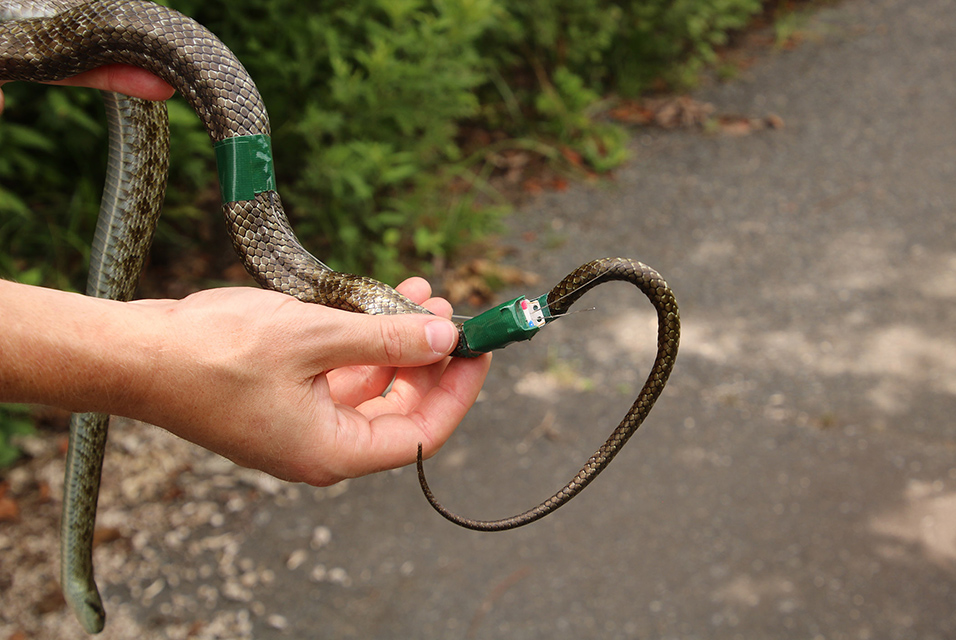ATHENS, GA.- Ten years after one of the largest nuclear accidents in history spewed radioactive contamination over the landscape in Fukushima, Japan, a
University of Georgia study has shown that radioactive contamination in the Fukushima Exclusion Zone can be measured through its resident snakes.
The team’s findings, published in the recent journal of Ichthyology & Herpetology, report that rat snakes are an effective bioindicator of residual radioactivity. Like canaries in a coal mine, bioindicators are organisms that can signal an ecosystem’s health.
An abundant species in Japan, rat snakes travel short distances and can accumulate high levels of radionuclides. According to the researchers, the snakes’ limited movement and close contact with contaminated soil are key factors in their ability to reflect the varying levels of contamination in the zone.
Hanna Gerke, an alumna of UGA’s Savannah River Ecology Laboratory and the Warnell School of Forestry and Natural Resources, said tracked snakes moved an average of just 65 meters (approximately 213 feet) per day.
“Our results indicate that animal behavior has a large impact on radiation exposure and contaminant accumulation,” Gerke said. “Studying how specific animals use contaminated landscapes helps increase our understanding of the environmental impacts of huge nuclear accidents such as Fukushima and Chernobyl.”
Why are snakes a good indicator of radioactive contamination?
James C. Beasley, Gerke’s advisor during the study, said snakes can serve as better indicators of local contamination in the zone than more mobile species like East Asian raccoon dogs, wild boar and song birds.
“Snakes are good indicators of environmental contamination because they spend a lot of time in and on soil,” said Beasley, associate professor at SREL and Warnell. “They have small home ranges and are major predators in most ecosystems, and they’re often relatively long-lived species.”
The team identified 1,718 locations of the snakes while tracking them for over a month in the Abukuma Highlands, approximately 15 miles northwest of the Fukushima Daiichi Nuclear Power Plant. The paper’s findings reinforce the team’s previous study published in 2020, which indicated the levels of radiocesium in the snakes had a high correlation to the levels of radiation in the soil where the snakes were captured.
How to track snakes
To determine where the snakes were spending their time and how far they were moving, the team tracked nine rat snakes using a combination of GPS transmitters and manual very-high frequency tracking. Beasley said VHF transmitters allowed the team to physically locate a snake every few days to identify if it was underground or in arboreal habitat.
The researchers placed the transmitters on the rear back of the snakes. Tape was initially placed around the snakes. Then superglue was used to ensure the transmitters were secured to the tape. This allowed the transmitters to easily be removed from the animals at the conclusion of the study.
Working in the hilly, rugged terrain of abandoned villages and farms, the team located snakes in trees, grasslands and along roadside streams. Gerke said the snakes avoided the interior of conifer forests but were often found in deciduous forests, along forest edges and inside of abandoned buildings. More than half of the tracked snakes, she said, spent time in abandoned barns and sheds, which can help shield them from contamination in the surrounding soil.
During winter months, their risk of exposure likely increases when they seek shelter underground, close to the more heavily contaminated soils. Future work to clarify the link between the micro-habitat use of species like snakes and their contaminant exposure, as well as the potential health risks to snakes and other wildlife due to increased radiation exposure, will be critical to understanding the effects of the Fukushima Daiichi accident on local wildlife populations.
Thomas G. Hinton served as coauthor on the study, Institute of Environmental Radioactivity, Fukushima University, Fukushima, Japan; Centre for Environmental Radioactivity, Norwegian University of Life Sciences, Faculty for Environmental Sciences and Nature Research Management, Aas, Norway.










